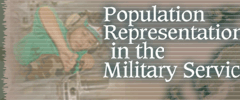|
Representation Within Occupations
The distribution of officers across occupational areas is shown in Table
6.7 for Active and Reserve Components. Overall, the largest proportions
of officers in the Reserve and Active Components are assigned to tactical
operations and health care positions (55 percent each). However, due to
assigned missions, the Reserve Components have a smaller proportion than
the Active Components in tactical operations (33 and 36 percent, respectively),
but a greater proportion of officers in health care (22 and 18 percent,
respectively).
| Table 6.7. FY 2002 Occupational
Areas of Active and Selected Reserve Officer Corps (Percent) |
Occupational
Area |
Active
Components |
Reserve
Components |
| General Officers and Executives* |
0.4 |
0.5 |
| Tactical Operations |
35.8 |
32.8 |
| Intelligence |
5.1 |
5.5 |
| Engineering and Maintenance |
11.9 |
9.7 |
| Scientists and Professionals |
5.5 |
6.8 |
| Health Care |
17.7 |
21.8 |
| Administration |
6.1 |
7.2 |
| Supply, Procurement, and Allied
Occupations |
9.1 |
9.9 |
| Non-Occupational** |
8.4 |
5.9 |
| Total |
100.0 |
100.0 |
| |
Differences in occupational assignment among the Reserve Components are
shown in Table 6.8. With the exception of the USAR, the largest proportion
of officers in each component is in tactical operations. Among the Reserve
components, the ARNG and USMCR have the greatest proportions of officers
in tactical operations (46 and 59 percent, respectively). The USAR has
the smallest proportion of officers in tactical operations (17 percent).
| Table
6.8. Comparison of FY 2002 Occupational Area Distribution of Officers
by Active and Reserve Component (Percent) |
|
Active and Reserve Components |
Occupational
Area* |
| 0** |
1 |
2 |
3 |
4 |
5 |
6 |
7 |
8 |
| ARMY |
| Active Component |
0.5 |
34.7 |
6.1 |
11.8 |
6.8 |
20.6 |
6.7 |
10.4 |
2.4 |
| Army National Guard |
0.6 |
45.5 |
3.3 |
8.0 |
3.6 |
10.4 |
5.8 |
10.2 |
12.7 |
| Army Reserve |
0.3 |
17.4 |
4.7 |
8.5 |
10.7 |
32.8 |
8.3 |
13.3 |
4.0 |
| NAVY |
| Active Component |
0.4 |
38.2 |
3.9 |
10.4 |
3.9 |
21.1 |
4.2 |
6.2 |
11.8 |
| Naval Reserve |
0.3 |
39.0 |
11.1 |
10.7 |
4.0 |
20.8 |
6.5 |
6.5 |
1.2 |
| MARINE
CORPS |
| Active Component |
0.5 |
51.5 |
4.9 |
8.1 |
3.0 |
0.0 |
6.2 |
13.8 |
12.0 |
| USMC Reserve |
0.3 |
58.5 |
5.0 |
7.7 |
5.7 |
0.0 |
6.3 |
14.8 |
1.7 |
| AIR
FORCE |
| Active Component |
0.4 |
31.5 |
5.1 |
13.9 |
6.1 |
16.4 |
7.0 |
8.9 |
10.8 |
| Air National Guard |
1.2 |
37.9 |
2.7 |
13.5 |
4.6 |
16.0 |
9.1 |
6.5 |
8.6 |
| USAF Reserve |
0.5 |
30.2 |
7.2 |
11.3 |
8.7 |
26.1 |
6.3 |
7.6 |
2.1 |
| |
Many Selected Reserve officers are health care professionals. The USAR
and USAFR have the greatest proportion of officers in health care occupations
(33 and 26 percent, respectively). Health care comprises the second largest
percentage of officers in the USAFR, ANG and USNR (26, 16 and 21 percent,
respectively). Relatively few Reserve officers are in intelligence, science
and professional, and administrative occupations.
previous | next
|





